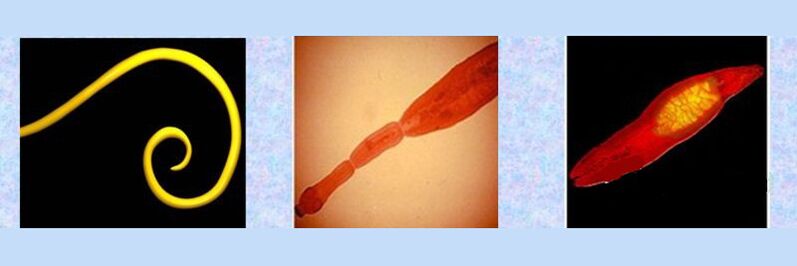There are various parasites that live in the human body, disrupting the functioning of the internal organs and the entire body as a whole. People knew about helminths in ancient times, and for the first time they and the diseases associated with them were described by Hippocrates.
Today, science knows many parasites, but some of them are particularly common in the human body. They differ from each other in structure and ways of existence, but for development and reproduction they must enter the human body.
Based on the type of structure, all parasites in humans are divided into several categories:
- roundworms;
- flows;
- cassette
Let's consider in more detail the listed types of parasites in the human body.
Characteristics of roundworms
These parasites are called nematodes. Outwardly, they resemble earthworms, but differ in sharper edges. Their sizes vary from one millimeter to 130 centimeters.
Many roundworms have a simple life cycle. After infecting the human body with nematodes, parasitic eggs emerge from the intestines, which are invisible to the naked eye.
When released into the environment, the eggs mature and then return to the human body through dirty food, water or dirty hands. Roundworms emerge from them and begin to develop actively.

All round parasites in the human body are divided into several subspecies, including:
- Red worms. The most common parasite that is easily transmitted between people through shared objects. The development of these nematodes in the body creates severe discomfort in the form of itching around the anus.
- Roundworms. When massively infected, they are dangerous to health. They are worms that reach a length of 25 cm. After maturation, the larvae spread throughout the body and internal organs in the blood.
- Trichinella. These tiny worms are up to 5 mm long. Developing in the intestines, they lay larvae. Then, they penetrate the blood vessels and spread throughout the body.
- Filaret. They are distributed mainly in hot countries, and their carriers are insects.
Parasites - fluxes
The so-called trematodes are parasites in the human body, the symptoms of which are not always visible. These are flatworms up to 8 centimeters long, which have suckers in their bodies to feed the parasites.
Flukes have a complicated life cycle and change hosts several times. Eggs develop in bodies of water, after which they enter the body of molluscs for metamorphosis. When the modified larvae emerge from the mollusks, they enter the body of crustaceans or fish, where they are modified again.
Flukes enter the body of their final host, which is a person, with raw or undercooked meat of cancerous species or fish.
Among the most popular trematodes are:
- Opisthorchis. People become infected with these parasites by eating lightly salted or undercooked carp or stroganina.
- Chinese fortune. It affects many fish and crustaceans living in Primorye and in the waters of Japan. The parasite affects the bile and bile ducts, the pancreas and the liver.
- Paragonimiasis. It provokes a dangerous disease that affects the lungs, liver, pancreas, kidneys and even the brain. People who eat uncooked crabs and lobsters from fresh water become infected with it.
- Schistosomiasis. Parasites are usually found in tropical countries, and the larvae actively enter through the human skin when swimming, as well as when water from a reservoir is put into the mouth.
Tapeworms (worms)
We have almost figured out what parasites are in the human body, but there are still tapeworms, which also come in different types:
- Bull bar. It can reach 10 meters in length and people become infected with it by eating beef that has undergone low heat treatment. Housewives sometimes get infected by testing raw minced meat for the amount of added spices or salt. After entering the body, the larva turns into salt, which sticks to the intestinal wall and causes weight loss, loss of appetite, insomnia and dizziness in humans.
- Pork loin. It is smaller in size (up to 2 meters in length), and can be infected by eating poorly cooked pork.
- Wide band. The length of this parasite varies from 6-15 meters. It is usually contracted by eating raw freshwater fish. Weakness, vomiting, nausea, abdominal pain and other symptoms appear.
- Echinococcus. A dangerous helminth that can be infected by cats and dogs that carry the parasite. In the human body, the larvae emerge from the eggs and are transported with the blood to various organs, especially the liver. Echinococcal cysts are then created, which are dangerous to health and require surgical intervention.
We looked at what parasites live in the human body, but these are not all known helminths. Study the symptoms of parasite infestation and if you find any, go to the doctor for diagnosis.






































